‘The Crown’ Used Lighting and Composition to Trap Its Characters Inside a ‘Fairytale’

- Oops!Something went wrong.Please try again later.
- Oops!Something went wrong.Please try again later.
Over “The Crown’s” four seasons, the halls of Buckingham Palace have become familiar visual signifiers for both the grandeur and the pressure placed upon the royal family. But in the third episode of this most recent season, “Fairytale,” cinematographer Adriano Goldman and director Benjamin Caron stretched the limits of the show’s visual language to create — and then to destroy — Princess Diana’s (Emma Corrin) fairytale fantasies.
Much of the episode is given over to Diana slowly realizing that, like many princesses stuck in a castle before her, she has fallen into a trap. But Goldman and Caron opened up the ways they shoot their Buckingham Palace sets to show how the demands of the Crown consume everyone on the eve of the fateful marriage.
More from IndieWire
'He's All That' Review: Soulless Netflix Clickbait Lacks All the Charm of the '90s Original
'Power of the Dog' Trailer: Jane Campion Returns to Filmmaking for First Feature in 12 Years
They force the jaws of the trap open wide with a pre-credits sequence of Diana’s night out with her friends after Charles (Josh O’Connor) proposes to her. The scene is a departure in every sense, not just to the swank ’80s members’ club that Diana frequents.
“You try to deliver something that is more romantic, a little bit more colorful, fun to start,” Goldman said of the sequence in an interview with IndieWire. “We wanted to not change the style too much, but there should be a transition from a very colorful pre-title sequence, a very interesting and more romantic beginning.”
That romance is on full display, most noticeably in the brighter, guadier colors of the club and much warmer tones of Diana’s Earl’s Court flat. But Goldman’s camera also interposes itself almost as a fourth (slightly intoxicated) friend, swinging around inside the girls’ cab to get a look at both Diana and Buckingham Palace, or flinging itself down onto the bed with the girls at the end of the night. The look of the sequence stands in contrast to the stately shots and slow tracks which are the show’s normal rhythm for everyone in the royal family. Well, for everyone in the royal family except maybe Princess Margaret (Helena Bonham-Carter), who gets to dance by a pool every now and again.
“We really considered how we could reverse [that fairytale opening] and be very present with her, and [how we could] make her feel young, actually. Part of this is she’s a young girl going into the palace,” Caron said.
Caron and Goldman gave the audience several visual signifiers that are easy to clock in this sequence, as well as Diana’s goodbyes to her friends that follows: the gold and neon hues of the night out, the warm, eye-level close-ups of Diana dancing in the club, and a signature spiral staircase Diana descends to begin her life as a princess.
Over the course of the episode, these colors will fade. The close-ups inch slightly above Diana’s eyeline, so that it feels like the camera, along with the rest of the Royals, is looking down on her. And when a spiral staircase reappears, it will lead to Diana’s lowest point.
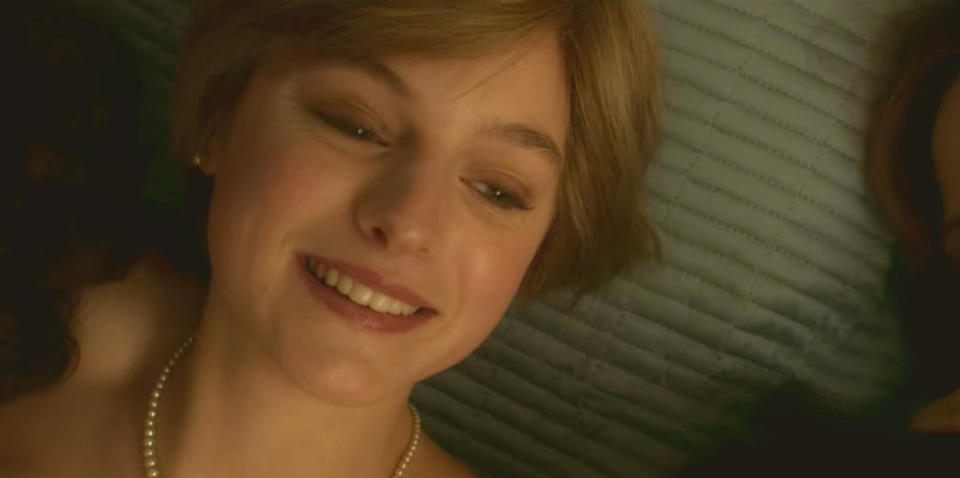
Screenshot
With Diana ushered inside Buckingham Palace to shield her from the press in the run-up to her and Charles’ wedding, Caron and Goldman emphasized how small and vulnerable Diana looks inside the palace walls. The opening of “Fairytale” had a long shot of the club, and Diana fit snugly within it. Once inside Buckingham Palace, the negative space often overwhelms Diana, and the camera backs away to show just how alone she truly is, perhaps best exemplified in the scene of her grandmother (Georgie Glen) physically tying her up while instructing her in how to speak like a royal.
Caron and Goldman deliberately call back to the romance of the opening to twist the knife, having Diana dance ballet inside the palace and then try to break out of the regimented structure of it as the pressure on her mounts. “I remember sort of holding the frame and I remember the camera operator was trying to follow us, but [I said no,] just hold the frame static and let her move in and around it,” Caron said. “So it really felt like someone trying to break out [of] somewhere.”
But of course, the camera never does let her leave the frame. Unlike the quick, fun cuts of Diana dancing in the club, there is no pressure release here. There is nowhere for Diana to go.
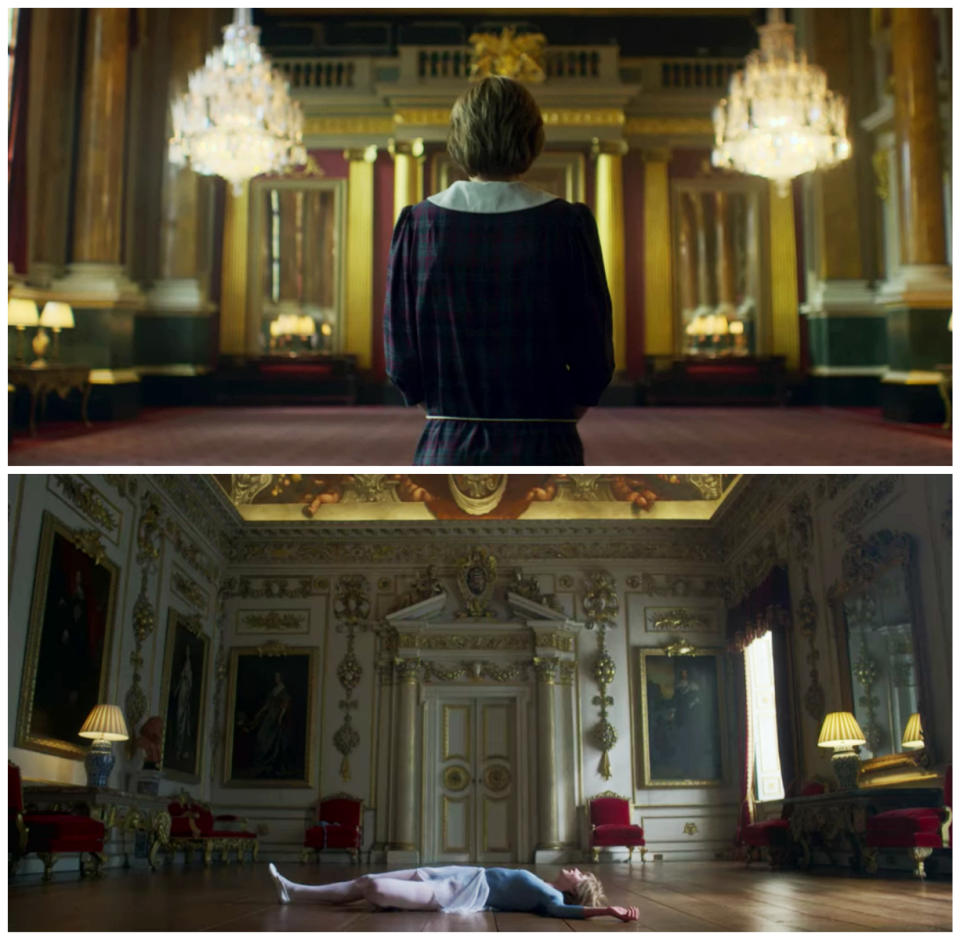
Screenshot
Caron wanted to use visual features that would feel right at home in a Disney princess story to their most punishing effect and perhaps the most powerful one of these motifs reoccurs when “The Crown” has Diana descend another spiral staircase. “[Ben] was very specific about this spiral because she’s going down on a spiral emotionally,” Goldman said of the shot that leads Diana down to the kitchen, a moment of late night desperation that kicks off her eating disorder. “He didn’t want to follow her on the steps, like on a steadicam. He wanted [the camera to be] facing down and going down with her to the very bottom of her feelings and her emotions.”
Caron described it as going to the “bottom of a well,” once Diana enters the kitchens and becomes enveloped in darkness — except for the fluorescent blues of the refrigerator lights, which makes the space feel like a morgue. This strong use of color, like all the changes in the episode, is grounded in the reality of whatever space Diana finds herself in. But the emotion and, indeed, the foreshadowing that Caron and Goldman are able to imbue those spaces with give Diana’s spiral real visual potency and a visceral sadness.
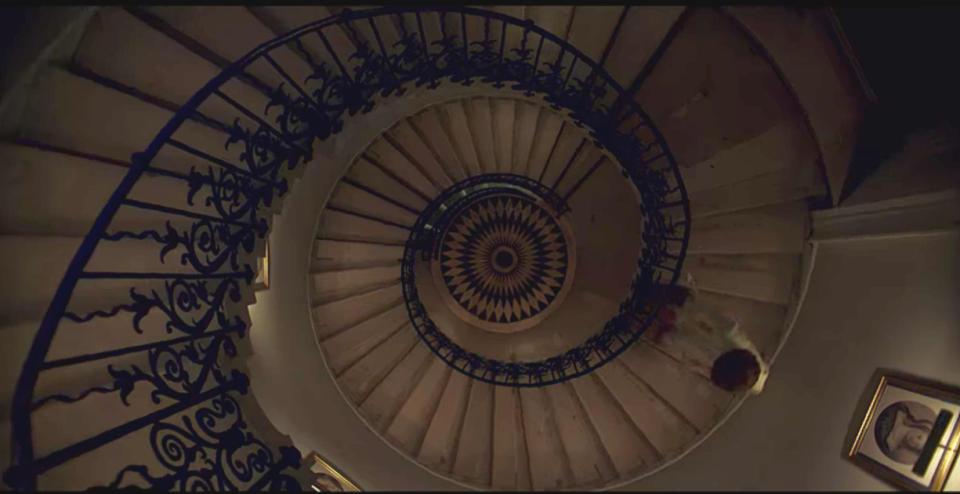
Screenshot
What is so thrilling about “Fairytale” is that it spares no one. Two striking scenes toward the end of the episode don’t have Diana in them at all, and yet push the series’ visual language to show how the palace and this marriage will swallow the characters who have been there all along.
In the first of these, Margaret tries to persuade Elizabeth, the Queen Mother (Marion Bailey), and Philip (Tobias Menzies) to call off the wedding. Caron wanted the scene to have a “conspiratorial, almost a Jacobian feel” to highlight the cold, businesslike calculations these four people are making for the happiness of two others.
“I remember saying to Adriano,’no no no, let’s go darker,” Caron said of this sequence and the next one. Goldman also recalled the desire to push the scene even further visually, lighting characters at harsh, dynamic angles or in almost complete shadow, so that the scene would feel spiritually closer to “The Godfather” than to the show’s usual style. The comparison is apt, given the mahogany browns and greens of the sitting room and the firelight that Goldman and Caron used to emphasize shadows falling into the crags on the characters’ faces. Vito Corleone could easily be sitting in a corner of one of those frames.
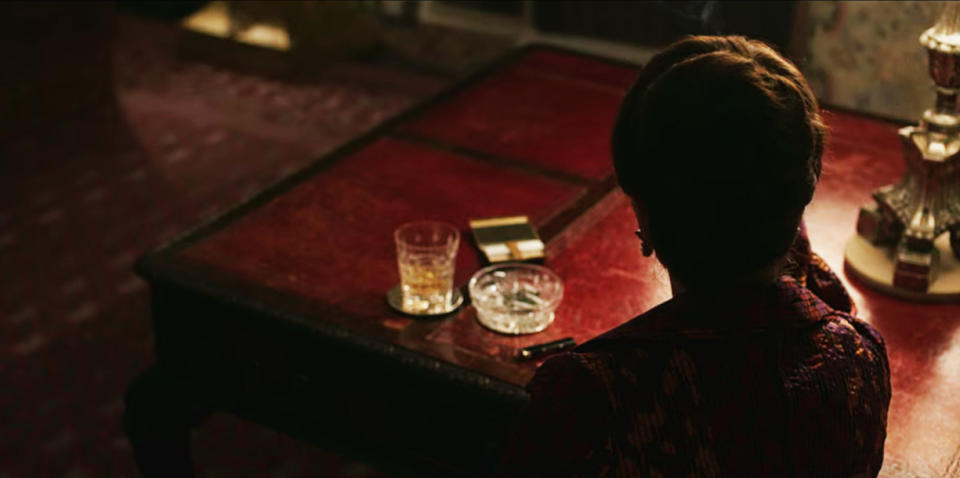
Screenshot
The next scene — when Elizabeth goes to find Charles and offer him a final few words on his marriage — Caron and Goldman viewed as a way to visually crystalize their relationship and how it is marred by their obligations to the monarchy. “Wouldn’t it be painful if you had Charles looking out the window and he felt the reflections of the fireworks and the noise and the celebrations outside?” Caron said about how he started conceiving of the blocking and framing of the exchange between mother and son. Each cinematic choice builds from a sense of what would be more painful, what would put more strain on the relationship.
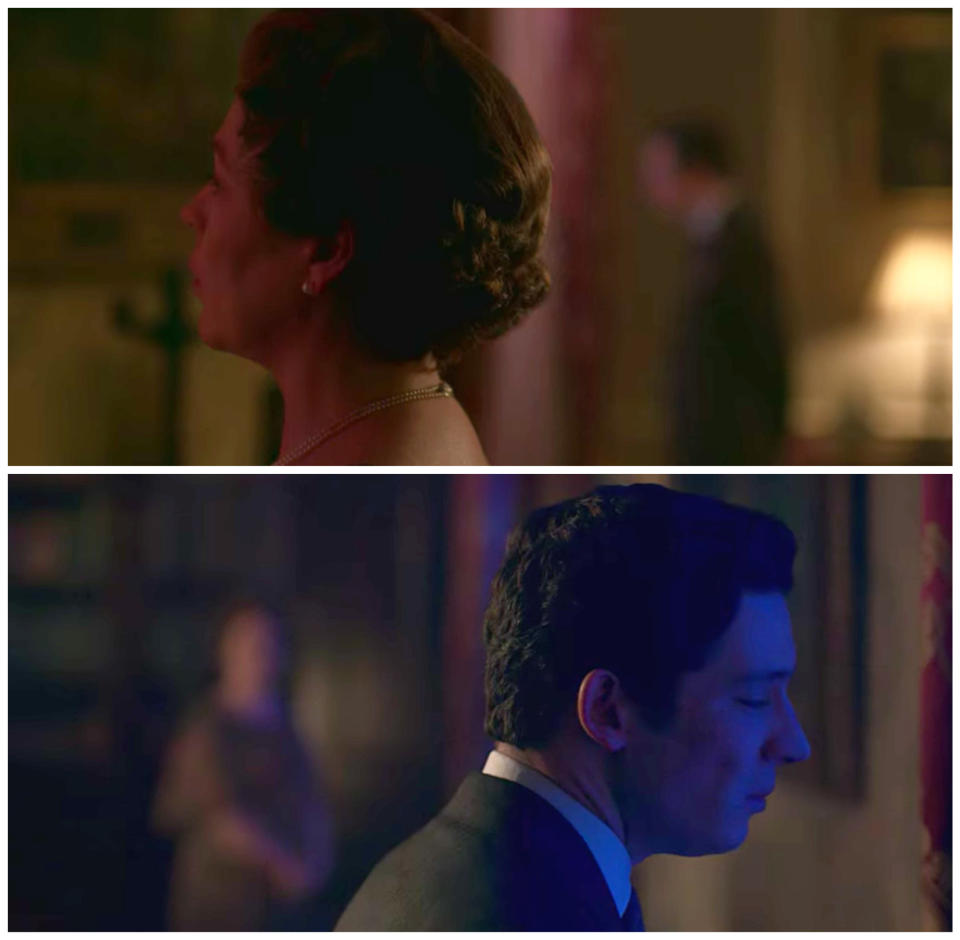
Screenshot
The filmmakers created this visual strain between Queen and Crown Prince not just by keeping them at opposite sides in the composition, but by keeping one of the pair always just out of focus in the shots with the two of them — they can’t even occupy the same level of detail in the frame. Color plays a role, too, with bright blues and reds from the fireworks, reflections of the Union Jack, always being part of the light through which the audience sees the resigned sadness on Colman’s face and the abject misery on O’Connor’s. Goldman said this is the scene where he realizes he will never escape the system of the monarchy. “He realizes it’s too late. It’s a trap. He’s been trapped.”
“It always comes back to the Crown,” Caron said, and it is really from the perspective of the Crown itself that we watch the characters prepare to head to church on the day of the wedding. When the audience finally sees Diana in her dress, she faces away from the camera and moves into that oppressive cavernous space which has put so much pressure on her throughout the episode. It’s a slow, almost funereal march toward the fate the audience already knows awaits her. Charles, on the other hand, gets the close-up this time. But the camera, with equal grimness, tracks slightly down and in, so that his face begins to loom over the frame, making him look monstrous.
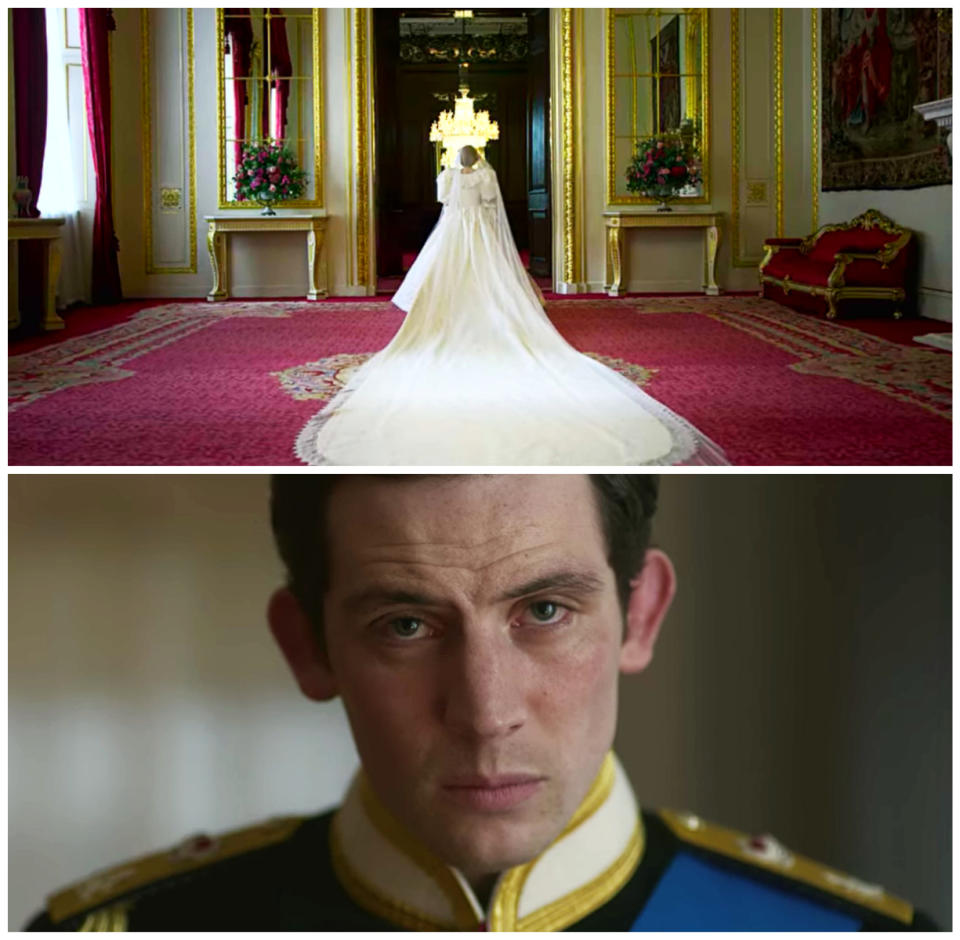
Screenshot
Of course by now, the visual choices that Caron and Goldman made for “Fairytale” have taught the viewer that there is another monster, a much more powerful one, looming over the episode’s final frame: The Crown is the monster that always gets you in the end.
Best of IndieWire
Sign up for Indiewire's Newsletter. For the latest news, follow us on Facebook, Twitter, and Instagram.


